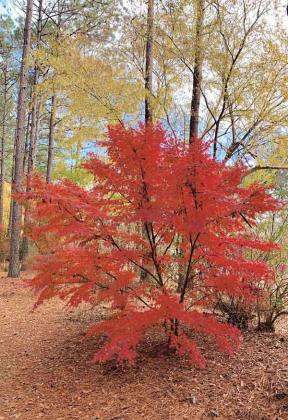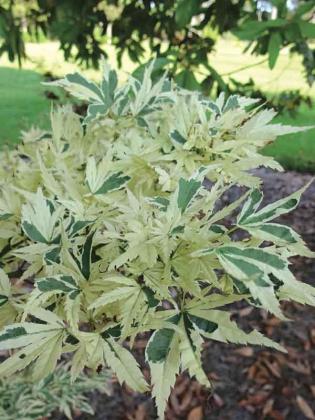

Heather Kirk-Ballard LSU AgCenter horticulturist
Japanese maple (Acer palmatum) is one of my favorite small trees for the landscape. These trees can provide a unique look to your garden and be a focal point of your landscape. The thought of Japanese maples brings an air of tranquility and visual thoughts of an Oriental garden.
Japanese maples made their way from Japan to Europe and the onto the United States in the 1800s by way of a Swedish doctor and botanist, Carl Peter Thunberg, who traveled to Japan and fell in love with these beautiful trees. Thunberg is credited with naming the plant palmatum because the leaves are shaped like a hand or palm with five points.
There are many different varieties of Japanese maples, with some growing to a height of 15 to 20 feet at maturity and a width of 10 to 15 feet. Spreading forms grow wider than tall. Some have with umbrella-shaped canopies. You can also find cascading forms and some dwarf varieties. All have unique leaves that make them so distinctive.
Leaf color and shape come in many variations from intricately serrated and jagged to a finer-textured foliage referred to as thread leaf forms. Leaves come in varied shades of lime, green and red all the way to a deep maroon.
Japanese maples provide interest in the landscape year-round. Most of the green-foliage varieties turn red or yellow in fall. Red-foliage varieties are susceptible to sun burning or scald during summer and early fall.
Maples favor cooler climates, and they grow best in USDA hardiness zones 5 to 8. Trees are cold hardy and will do well in the northern parts of Louisiana. Growing trees in the more southern parts of the state can be tricky, especially in zone 9. However, it can be done in the proper planting site.
Most varieties should be planted in partial sun to partial shade. Protect plants from drying winds with mulch to protect the shallow root systems. In full sun, some varieties will burn, especially in summertime heat. Plant maples in areas that get morning sun rather than afternoon sun. Foliage color will be more vibrant in sites that get just a tad bit more sun.
Japanese maples are very slow growing at about 1 to 2 feet per year. But they can live for up to 100 years, so they are a long-lived tree. Once established, Japanese maples are low-maintenance trees. You can prune them lightly during winter for the first five years to obtain the desired shape. Apply light applications of slow-release fertilizer in early spring before new growth once a year for the first few years. You can fertilize every couple of years thereafter.
Red-leaf cultivars remain the most popular, with the bright green cultivars being a second favorite. There is a species designed to thrive in almost every type of soil condition. However, none fare well in overly boggy conditions, and they must be watered during times of drought.
In addition to their gorgeous leaves, Japanese maples also produce inconspicuous flowers that are followed by fruits called samaras. These fruits are tiny nutlets enclosed in a papery tissue in the shape of wings that spin as they fall. It looks as if they are dancing as they spin in the air and are carried off by the wind to considerable distances. It is truly a sight to see.
Trees can be grown from seed but may not be true to type. They can also be grown from cuttings, but this is a challenge, as most cuttings are weak and slow-growing and do not overwinter well. Most of the Japanese maple trees you see in garden centers are grafted onto a more vigorous rootstock.
Japanese maples are monoecious, having both male and female flowers on the same plant. Flowers and seeds provide ecosystem services. The small, inconspicuous flowers attract many birds, including grouse, quail and other songbirds. The seeds are excellent food sources for squirrels, chipmunks and other small mammals.
You can find many varieties of Japanese maples, including Bloodgood, Burgundy Lace, Coral Bark, Crimson Queen, Emperor One, Fireglow and Tamekeyama. Many are available at local Louisiana garden centers.
Crimson Queen is a low-branching, dwarf tree with a delicate, weeping form. It is sun tolerant in colder climates, but in warmer climates, it performs best in bright areas with dappled sun. Red Dragon is said to be more heat tolerant, but it is a slow-growing tree that may be suitable for more southern climate of the state.
If you don’t have a place in the landscape suitable for a tree, smaller varieties are excellent for container plantings on patios and other protected areas with partial sun.
The AgCenter Hammond Research Station has an evaluation and collection program with more than 100 Japanese maple varieties currently planted. Late fall and early winter are a great time to go out and see these maples as they put on their fall foliage change. It can be simply breathtaking.
Fun facts about Japanese maples: In Japan, the maple is called the “autumn welcoming tree” and is planted in the western portion of gardens (the direction fall comes from). Additionally, deep-fried maple leaves are a delicacy in Japanese cuisine.
